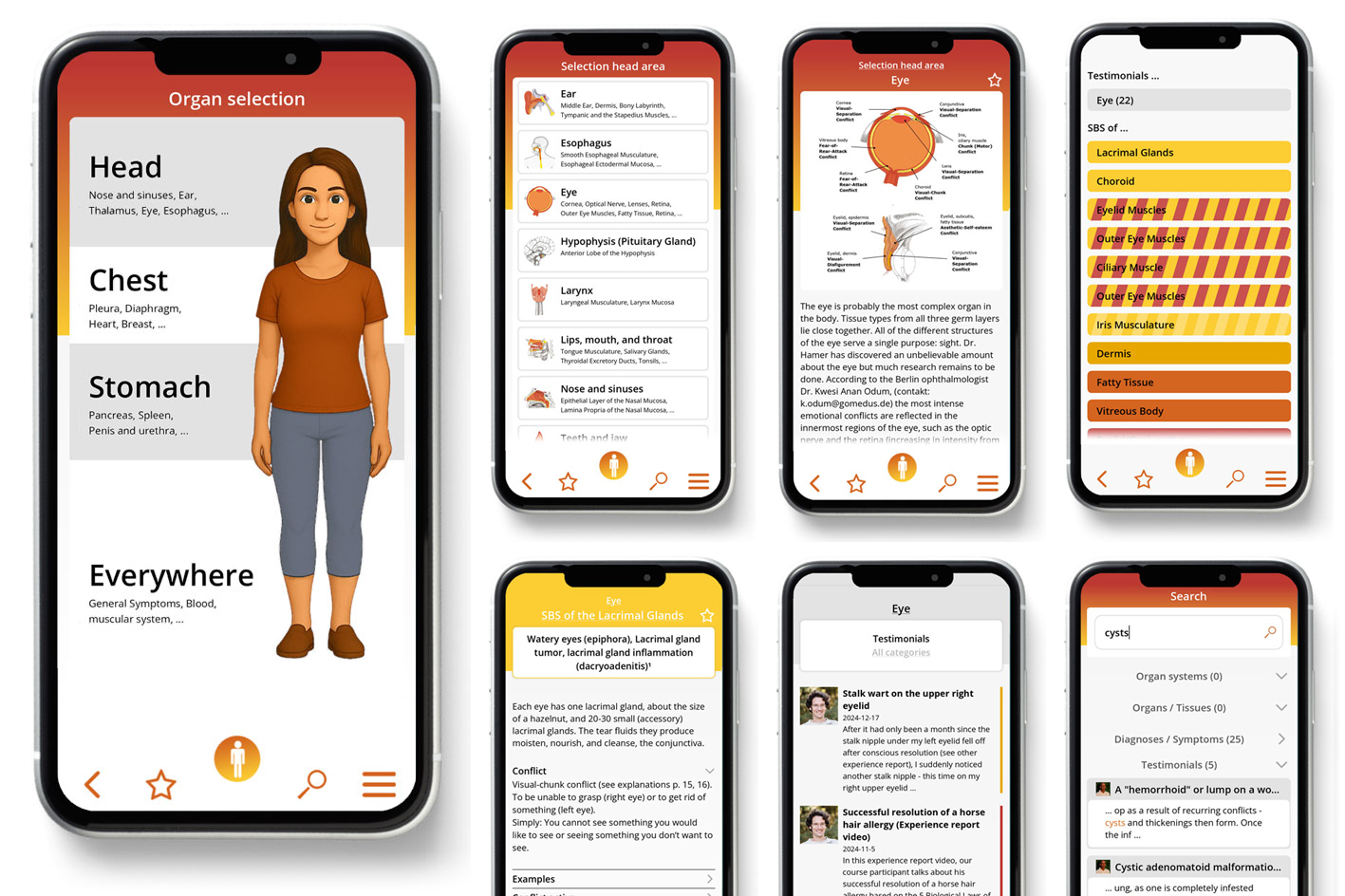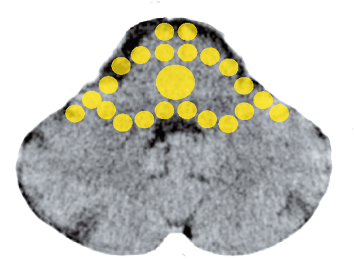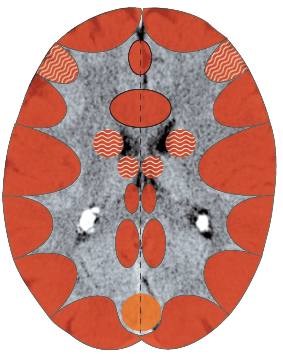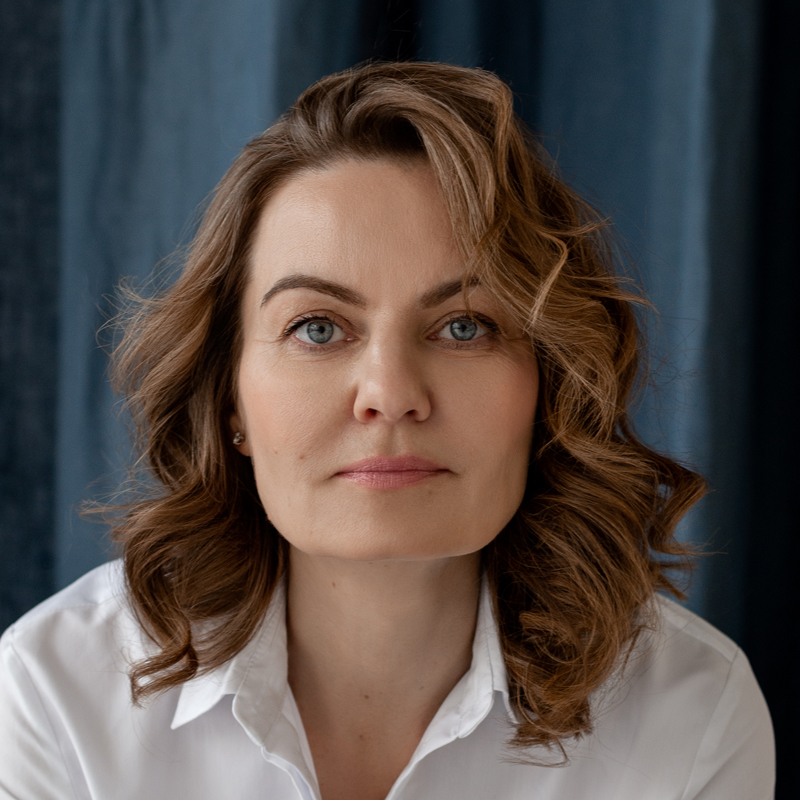 The information on this site is from one of the most famous books about the New Medicine (GNM / 5BN): "The Psychic Roots of Diseases" by Björn Eybl. Since September 2025, it is available in the form of an app with many additional features.
The information on this site is from one of the most famous books about the New Medicine (GNM / 5BN): "The Psychic Roots of Diseases" by Björn Eybl. Since September 2025, it is available in the form of an app with many additional features.It was written in german and was translated into more than 10 languages already. German is not freely available, as the rights are held by a publisher, but all these translations are available as ebooks / PDFs for free, as a gift of Björn for you, for the New Earth, for a new time.
In cooperation with Björn, it is splitted on "Disease is Different" into the sections by organ systems and combined with the real cases of our international testimonial / report archive of the related organ system.
ESOPHAGUS
The approximately 25 cm (10 in) long, muscular food pipe — the esophagus — transports food pulp from the pharynx to the stomach using peristaltic (undulating) motions.
The esophagus is composed of endodermal intestinal mucosa with involuntary muscle underneath.
In the upper two-thirds of the esophagus, ectodermal epithelium, composed of voluntary (striated) muscle which migrated from the mouth, lies over the old intestinal mucosa (ectodermal squamous epithelium and voluntary striated muscle usually make a pair).
In the illustration below, you see two ectodermal areas located in the otherwise endodermal digestive tract: The lesser curvature of the stomach along with the pyloric sphincter and the last inch of the rectum and anus.

Superficial Esophageal
Mucosa (upper two-thirds)
Not wanting to swallow
something
Esophageal Submucosa
(lower third)
Chunk conflict, not being
able to swallow something

Endodermal esophageal cancer (adeno-ca)1
This cancer normally develops in the lower third of the esophagus. It can also occur in the upper two-thirds, as a “leftover“ of the old intestinal mucosa or below the squamous mucosa (submucosal).
| Conflict | Chunk conflict (see explanations p. 15, 16). Not being able to swallow something. One wants to swallow something but is prevented from doing so. One wants something but does not get it. |
|---|---|
| Example | ➜ Someone is left empty-handed in terms of money, inheritance, pension, even though they counted on it. A 70-year-old, married retiree likes most of all to spend time tending to his leased garden. As he returns from a summer vacation, he finds a backhoe digging up the garden = conflict, the garden (= chunk) can’t be ingested — he can no longer “embody” it. In the active-phase, a “malignant“ adeno-ca develops. The patient has trouble swallowing. Fortunately in the meantime, he has been promised a new garden = beginning of the repair phase with night-time coughing and spitting up of caseated pieces of the tumor. (See Claudio Trupiano, Danke Doktor Hamer, p. 161) A 70-year-old, married retiree likes most of all to spend time tending to his leased garden. As he returns from a summer vacation, he finds a backhoe digging up the garden = conflict, the garden (= chunk) can’t be ingested — he can no longer “embody” it. In the active-phase, a “malignant“ adeno-ca develops. The patient has trouble swallowing. Fortunately in the meantime, he has been promised a new garden = beginning of the repair phase with night-time coughing and spitting up of caseated pieces of the tumor. (See Claudio Trupiano, Danke Doktor Hamer, p. 161) |
| Conflict-active | Increased function. Growth of a cauliflower-like tumor of secretory quality or a flat-growing tumor of absorptive quality. Narrowing of the esophagus, swallowing difficulties. Possibly only pureed or liquid food can be swallowed = esophageal stenosis. |
| Bio. function | Secretory quality: To produce more digestive juices to break down the chunk that is stuck in the esophagus so that it can actually be swallowed. Absorptive quality: To be able to absorb the chunk through improved up-take of nutrients. |
| Repair phase | Normalized function and/or tubercular caseation of the tumor. Degradation via fungi or bacteria. Inflammation of the esophagus (esophagitis, esophageal thrush). Pain behind the breastbone. Danger of unnoticed bleeding (black stool, “occult blood“). Night sweats, mild fever. Aggravated by syndrome. Possibly scars, diverticula (bulges where the tube has been weakened) or so-called esophagus rings and membranes may remain. |
| Repair crisis | Severe pain, bleeding, chills. |
| Questions | Complaints since when? (Conflict previous). What am I not allowed to incorporate/take in/embody? (Sum of money, something important to me, a better life)? Why is it so important to me? (Work out conditioning, e.g., early childhood experiences of not getting something). Why is this thing more important than my life? What is my attitude toward ownership/possessions? What is the meaning of life? |
| Therapy | Determine the conflict and conditioning and, if possible, resolve them in real life. Guiding principles: “I am satisfied with what I have.“ “There is a reason why this has happened.“ “That’s it, done!“ If necessary, OP without chemo or radiation. |
“Varicose veins in the esophagus“ (esophageal varices)
Same SBS as above. In CM, this is seen as congestion in the portal vein system. This hypothesis is questionable — more than likely, this is an SBS of the esophagus.
| Phase | Recurring—conflict or the condition thereafter. Extremely dilated submucosal veins in the lower third of the esophagus = blood vessel scar tissue. |
|---|---|
| Therapy | Identify the conflict and conditioning and, if possible, resolve them in real life so that the SBS comes to an end. In the case of acute, threatening hemorrhage: OP (rubber band ligation or sclerotherapy). |
1 See Dr. Hamer, Charts, p. 21

Ectodermal esophageal cancer (ulcer-ca)1
This type of cancer only grows in the upper two-thirds of the esophagus.
| Conflict | Not wanting to swallow (accept) something, wanting to spit something out again. One would rather just vomit and rebel — but they don’t do it. |
|---|---|
| Examples | ➜ “It’s a hard pill to swallow.“ “That’s going to be hard for me to swallow.“ ➜ “That‘s hard to swallow!“ (E.g., accusation, loss of work, stroke of fate.)  A very honest postman is accused by his boss of having embezzled a package containing a large sum of money = conflict of not wanting to swallow the accusation. Growth of an esophageal cancer in the active—phase. It is diagnosed in the repair phase. (See Dr. Hamer, Krankheit der Seele, p. 296) A very honest postman is accused by his boss of having embezzled a package containing a large sum of money = conflict of not wanting to swallow the accusation. Growth of an esophageal cancer in the active—phase. It is diagnosed in the repair phase. (See Dr. Hamer, Krankheit der Seele, p. 296) The patient is a glassblower and comes back to his workplace following a vacation. He is stunned to learn that an apprentice has taken his place. He has a big row with his supervisor = not wanting to accept the fact. (See Dr. Hamer, Krankheit der Seele, p. 218) The patient is a glassblower and comes back to his workplace following a vacation. He is stunned to learn that an apprentice has taken his place. He has a big row with his supervisor = not wanting to accept the fact. (See Dr. Hamer, Krankheit der Seele, p. 218) |
| Conflict-active | Increased sensitivity, pain. If prolonged, cellular breakdown of the squamous epithelium (ulcerous carcinoma). Simultaneous slackening of the underlying, ring-shaped smooth muscle > cross-sectional enlargement. |
| Bio. function | By increasing the diameter of the esophagus, the chunk can be better expectorated or vomited. |
| Repair phase | Restoration of the mucous membrane. Inflammation of the esophagus (esophagitis, herpes or cytomegalic esophagitis, glycogen acanthosis, no pain, but swelling and swallowing difficulties). Aggravated by syndrome. The patient can be left with scars, diverticula or so-called esophageal rings and membranes. Possibly a recurring conflict. |
| Repair crisis | Pain, possibly heavy bleeding > melena (tarry stool), chills. |
| Questions | Study the histological findings and determine if it is an adeno-ca (yellow group) or a squamous cell-ca (red group). Determine if one is in vagotonia or still in the active phase: sleep in the early morning, hand temperature, fever, appetite, dreams? Estimate the time period of the conflict. If in the active phase: What don’t I want to swallow? (Determine the exact situation). Do I generally acquiesce a lot? What is stressing me? Are there taboo topics? (These are often a source of conflict). What conditioning makes me sensitive to this issue? (Childhood experiences, experiences of the parents/ancestors)? Which belief(s) has paved the way for the conflict? (E.g. Being everything for everyone. One is only loved when one is well-behaved. It’s better not to be conspicuous). Are/were there similar conflict situations among my ancestors? (If yes, resolve the family issue through healing thoughts/meditation/prayers). |
| Therapy | Identify the conflict and conditioning and, if possible, resolve them if they are still active. Guiding principles: “I will only swallow what’s good for me.“ “I won‘t let anyone force anything down my throat anymore.” “I am at peace with everything.“ If necessary, surgery without chemo or radiation. |
1 See Dr. Hamer, Charts pp. 122, 135
Esophageal spasm/food bolus obstruction, “steakhouse syndrome,” achalasia
The two-layered esophageal muscles transport swallowed food into the stomach by means of peristaltic waves.
| Conflict | Not wanting to ingest whatever (bad) was involuntarily swallowed. Not wanting to accept something. |
|---|---|
| Example | ➜ “I couldn’t repeat the accusations, because they got stuck in my throat.” a During the corona lockdown, a 60-year-old suffered from extremely painful esophageal cramps while drinking beer and eating — his days of carefree eating are over. The Cause: Heated discussions about the corona crisis being staged. = Conflict, can’t accept the opinions of others. Conditioning: His father was opinionated and belligerent. Therapy: Before drinking/eating he should go to his father in his thoughts and tell him that they have something to resolve together (blessing/acceptance instead of emotional arguing). His symptoms disappeared within a few days. (Archive B. Eybl) |
| Phase | Recurrent conflict. Esophageal cramps are the healing crises of this SBS. The food gets stuck on its way to the stomach. Lumps and/or severe pain in the throat and/or chest area, panic. |
| Bio. function | The ring muscles of the esophagus contract to prevent the bad morsel from being swallowed. The cramps in the epicrisis indicate that something unacceptable was previously swallowed. |
| Questions | When did the symptoms begin? (Indication of the beginning of the stressful situations) What couldn’t/can’t I swallow/ingest/accept? Why is it so difficult for me to deal with opposition? Did any of my ancestors have similar difficulties? Which? Which strategies will I use to adapt? |
| Therapy | Determine and resolve the conflict and conditioning. Guiding thoughts: “I will only swallow what’s good for me.” “I disagree with and bless my counterpart.” Magnesium chloride foot baths, cannabis, peppermint oil. If nothing else helps, possibly a CM botulinum toxin injection, calcium channel blockers/antagonists orally. |
All experience reports on the organ system «Esophagus» from the International Report Archive:
| Author | Title and Overview | Keywords | ||||
|---|---|---|---|---|---|---|
 | 2024/11/21    Конфликт неспособности принять кусок. Унижения со стороны его жены, в браке 30 лет. Прошел курс ЛХТ, не до конца, та как тяжело проносил, через 1 мес - рецидив опухоли, далее по пути аллопатии не пошел, пришел в сессию. Нашли конфликт непринятия "отношения жены с унижениями". Через 4-5 месяцев после сессии - стойкая ремиссия. На текущий момент почти 5 лет стойкая полная ремиссия.  | онкология | ||||
 | 2023/07/29   Acid reflux, because something swallowed simply cannot be "accepted" and thus cannot be "digested" in the stomach. | |||||
 | 2021/08/19    Case report of a boy with eating disorder: During the analysis, the therapist was able to determine the cause as dysphagia and spasm of the smooth muscles during the ingestion of solid parts of food. The first occurrence was after a meal where parts of food were stuck in the throat. With specific food changes for shorter periods of time, the boy was able to overcome the fear of another occurrence, so that he was able to eat normally again.- A case report from the internat. Congress of the A.L.B.A 2011. |
